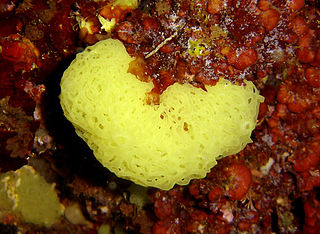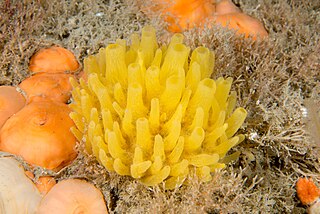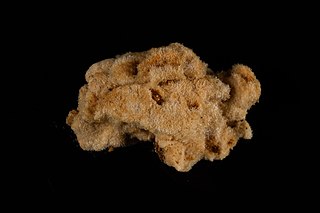
Leucosolenida is an order of sponges in the class Calcarea and the subclass Calcaronea. Species in Leucosolenida are calcareous, with a skeleton composed exclusively of free spicules without calcified non-spicular reinforcements.

Clathrina is a genus of calcareous sponge in the family Clathrinidae. Several species formerly in Clathrina were transferred to the newly erected genera Arturia, Ernstia, Borojevia, and Brattegardia in 2013. The name is derived from the Latin word "clathratus" meaning "latticed".

Grantia is a genus of calcareous sponges belonging to the family Grantiidae. Species of the genus Grantia contain spicules and spongin fibers.

Polymastia is a genus of sea sponges containing about 30 species. These are small to large encrusting or dome-shaped sponges with a smooth surface having many teat-shaped projections (papillae). In areas of strong wave action, this genus does not grow the teat structures, but instead grows in a corrugated form.

Chondrocladia is a genus of carnivorous demosponges of the family Cladorhizidae. Neocladia was long considered a junior synonym, but recently become accepted as a distinct genus.

Homosclerophorida is an order of marine sponges. It is the only order in the monotypic class Homoscleromorpha. The order is composed of two families: Plakinidae and Oscarellidae.
Clathrina parva is a species of calcareous sponge in the family Clathrinidae, found off the Queensland coast of Australia.
Clathrina wistariensis is a species of calcareous sponge in the family Clathrinidae from Australia, off the Queensland coast.
Ascute asconoides is a species of calcareous sponge found in Australia.
Ascute uteoides is a species of calcareous sponge found in Australia.
Homaxinella is a genus of sea sponges in the family Suberitidae. The type species is Homaxinella balfourensis.

Dictyoceratida is an order of sponges in the subclass Ceractinomorpha containing five families. Along with the Dendroceratida, it is one of the two orders of demosponges that make up the keratose or "horny" sponges, in which a mineral skeleton is minimal or absent and a skeleton of organic fibers containing spongin, a collagen-like material, is present instead.
Guancha apicalis was thought to be a species of calcareous sponge in the genus Guancha from Antarctica. It actually never existed.
Baeriidae is a family of calcareous sponges in the class Calcarea. It was named by Borojevic, Boury-Esnault, and Vacelet in 2000. The type genus is BaeriaMiklucho-Maclay, 1870, by original designation, though Baeria is now considered a junior synonym of LeuconiaGrant, 1833.
Soleneiscus radovani is a species of calcareous sponge in the family Dendyidae, and was first described in 1999 by Gert Wörheide and John Hooper. The species epithet, radovani, honours Radovan Borojevic for "his substantial and pioneering achievements in calcarean taxonomy".
Leucetta villosa is a species of calcareous sponge in the family Leucettidae, and was first described in 1999 by Gert Wörheide and John Hooper. The species epithet, villosa, comes from the Latin, villosus ("hairy"), and was given because of the "hair-like extensions on the sponge surface".

Leucetta is a genus of sponges in the family Leucettidae, which was first described in 1872 by Ernst Haeckel. The type species is Leucetta primigenia Haeckel, 1872 by subsequent designation.

Leuclathrina is a genus of sponges belonging to the family Dendyidae. Species are found in the northeast Atlantic and in the Indian Ocean.

Leucettusa is a genus of sponges belonging to the family Leucaltidae. The species of this genus are mostly known from the Arctic and Antarctic, New Zealand and Southwest Australia.









